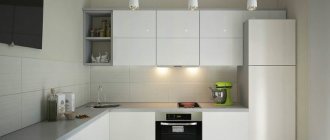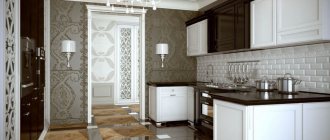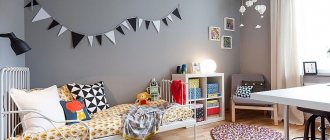Exotic Japanese-style kitchen design is now often found in modern interiors. Harmony and tranquility in color schemes are perfectly combined with natural accents characteristic of the traditions of the East.
The laconic Japanese style is universal and suitable for interior decoration of both small rooms and spacious rooms
Features of Japanese style in kitchen design
The simplicity of design solutions in this style allows you to decorate a room on your own, without the help of specialists. Restraint in design and minimalism in kitchen furniture will allow you to create this style in any area of the room; it will be enough to make a few accents in an oriental theme on the walls.
Natural materials, natural light and a minimum of details - the foundations of Japanese interiors
Features of Japanese style in the interior:
- natural materials in the decor of the room - bamboo, wood and stone;
- the use of natural natural colors in design - white and beige, green and brown, red and black;
- a minimum of decorative elements and accessories - nothing superfluous on the shelves of the kitchen set;
- symmetry in the shapes and dimensions of furniture in the kitchen - when decorating a room in this style, it is better to use multifunctional built-in appliances;
- soft natural lighting of the room with additional lighting of all areas in the kitchen;
- mandatory details in the interior, emphasizing the style of the East, for example, panels with Japanese writing or sakura;
- It is better to choose retractable doors in the kitchen in the form of a light partition or screen made of light wood.
Even a small Japanese-style kitchen looks a little larger than it actually is. It's no secret that the Japanese have achieved perfection in terms of visual expansion of space.
The design of a Japanese-style kitchen in the photo looks very simple, but functional, and with this simplicity it is easy to combine the overall style of your apartment, for example, with an emphasized rigor of minimalism and classics.
In Japanese cuisine, perfect order always reigns, so you have to throw out everything unnecessary that you haven’t used for a long time
What materials and finishing will be required?
The first and unshakable rule for choosing materials is a maximum of natural materials. This is, first of all, wood, bamboo, textiles.
The walls can be covered with decorative plaster or covered with wooden panels. In terms of color, it is better to give preference to a light, neutral palette. The national flavor will be well emphasized by decorating one of the walls in the form of shoji - a partition made of transparent or translucent fabric stretched over a wooden frame.
The kitchen floor in Japanese motifs is polished dark wood, the ideal option is board or parquet. However, the cost of a natural, environmentally friendly coating is quite high, so you can choose a less expensive material - square tiles. A harmoniously selected combination of white and brown tones will emphasize the overall composition of the interior.
For the ceiling, choose a suspended structure, or arrange a shelf space in a two-level design. You are also welcome to choose from the following options:
- installation of wooden beams;
- use of ceiling wallpaper;
- stretch ceiling with photo printing.
The last proposal is the most popular, especially with the image of cherry blossoms. The delicate vibrant color of the flowers will add additional oriental charm and elegant charm to the design of a Japanese-style kitchen.
Color solutions for design
The main thing when choosing a color in this design is monochrome, a combination of no more than two colors in the interior. The main dominant color is usually white, beige or light brown walls combined with individual accents of stone and wood in the work area and bright furniture.
The color palette of Japanese interiors is as close to nature as possible
Brown color is associated with the reliability and warmth of natural wood
Green color looks expressive when surrounded by woody structures
For the Japanese, red signifies strength and masculinity, gives warmth and life.
Black and white kitchen - playing with contrasts is encouraged in the Japanese interior
The main characteristic feature of the oriental style is the creation of a contrast of light and dark colors when finishing the ceiling and floor. If you have light wood floors, choose furniture in a darker shade; if you have darker floor tones, choose light wood furniture.
Bright accents in details are another feature of the Japanese-style interior
Application of design in a small kitchen
The color scheme and rationality of Japanese cuisine allows it to be used in small spaces. To create a Japanese-style kitchen with your own hands, use light-colored finishing materials. Avoid ceiling beams - these complex structures will make low ceilings even lower and visually make the room smaller. If you really want beams, you can make thin beams from plasterboard; they will not hang down much and at the same time decorate the ceiling.
Lighting for a small space is done in the same way as standard - floor, wall lamps and lamps with dim light, additionally illuminating work areas. Furniture cannot be bulky. You can choose open shelves, partitions on the facade of a kitchen unit inspired by Japan, giving lightness to the room. You can decorate the space with photo wallpapers with drawings of sakura, monasteries and gazebos, vases and paintings with thematic designs.
Decoration materials and accessories
Basic decorative elements:
- a niche in the wall with shelves on which you can place an elegant Japanese vase made of thin glass, a wooden box, or hang a clock in a wooden design;
- for windows use light panel curtains made of natural fabrics in the same color with bright kitchen furniture or blinds made of bamboo and mats;
- wall panels and fans with texts in Japanese, cherry blossoms and floral patterns;
- Ikebana and wall prints are a mandatory attribute of the oriental style;
- a bonsai tree or bamboo in a small pot on the floor or windowsill will perfectly complement your interior and add a natural element to it, which the Japanese love;
- a small stone fountain in the dining area, the sound of which will help you relax and unwind after work.
Avoid lots of small parts and utensils on display. Such diversity visually reduces the space
The decor should be precise and expressive. For example, you can put on the table a vase with a composition compiled according to the rules of ikebana
Do not add a lot of decorative elements to the interior; a few oriental accents in the room will be enough, because the kitchen is a functional room in which you prepare food.
Combination with wallpaper, curtains and decor
Japanese-style wallpaper is a canvas of natural shades that emphasizes the style of the room and visually adjusts the space: hides flaws and draws attention to advantages.
Wallpaper in white, beige and gray colors goes well with the set. Both plain surfaces and those with original and bright patterns are suitable: Japanese inscriptions, photographs of cranes, images of ancient Japanese monasteries. The main thing is that the walls look calm and concise.
Important! In the production of most Japanese wallpaper, natural materials are used as dyes or adhesives. Often the canvases imitate bamboo, straw or rattan. Wallpaper must be resistant to moisture and sun. Pay attention to vinyl or non-woven fabrics.
Instead of traditional curtains and curtains, Japanese blinds are used. They are made of lightweight translucent material that is easy to clean and retains a fresh look for a long time. Blinds consist of panels, the number of which varies from two to eight.
Initially, they were used not for window decoration, but for zoning space. Blinds are made from bamboo, straw, cotton or linen. Japanese curtains for the kitchen do not absorb light, but, if necessary, cover the kitchen from it. Such curtains look laconic and do not overload the space.
Natural or artificial green flowers, tablecloths made of natural fabrics, bamboo napkins or traditional ikebana are harmoniously combined with Japanese cuisine. It wouldn’t hurt to decorate the set with pottery for the tea ceremony, which can be purchased in the store. Remember that Japanese style is dominated by minimalism and does not require excessive decoration.
Choosing furniture for the kitchen
When choosing a kitchen set, pay special attention to the quality of the wood from which it is made. The materials from which oriental-style furniture is made are dark walnut, black ash, mahogany, birch or beech. If it is not possible to buy furniture made from natural materials, choose a set stylized as wood. The ideal option is furniture made of light and light wood with facades decorated with traditional oriental motifs in the form of images of sakura, plants and birds. It is acceptable to use frosted glass on the doors of the set, stylized as rice paper, which is used in the decoration of premises in the east.
For a dining group, an exclusively wooden table with straight shapes is selected
This style is matched by a wooden dining table and dark unpainted wood chairs in the dining area. A mandatory attribute on the table is a rough mat or rug made of bamboo. The table can be of regular height or low if you want to create an interior that fully matches the oriental flavor. You can place a table against the kitchen wall, but a dining area with a small table in the middle of the room surrounded by small seat cushions will look better.
Furniture sets should not overcrowd the room or cramp the space. The ideal solution would be to purchase a thematic collection from a well-known manufacturer
If the room allows, place a small sofa upholstered in matting and add several small pillows made of the same material.
When choosing a bright kitchen set, three colors are usually used in this style: red, black and green. Do not use other colors; with them you will not be able to decorate your kitchen in an oriental style. It is better to use black furniture in rooms with a large area, otherwise it will visually reduce the space and the room will seem dark and gloomy.
Try to adhere to the principle - the more modest the dimensions of the room, the fewer pieces of furniture should be in it
When decorating a room in this style, use a minimum amount of furniture, only the essentials. In a Japanese interior, everything should be concise, simple and functional.
Lighting and additional lighting
Japanese style implies soft natural lighting with additional lighting of functional areas in the kitchen. The use of chandeliers on the ceiling is minimal. Small lamps in the form of paper lanterns made of frosted glass with a metal or wooden frame and decorated with hieroglyphs or natural ornaments are acceptable. Lampshades in geometric shapes, round, square or hexagonal on the ceiling. Now you can purchase a plastic version of such lamps, which are safe to use and will not disrupt the overall style of the room. The work area in the kitchen can be illuminated with several small LED lights or strip lights.
The Japanese prefer diffused light, so the best solution would be built-in ceiling lighting
In addition to built-in light sources, you can hang chandeliers in oriental style
In the East, floor lamps are often used in the form of a large vase, which can be placed next to the dining area. Small wall-mounted options in the form of lamps or lanterns will help highlight the main functional areas in the kitchen and add coziness.
Lamps with shades made of rice paper look beautiful
Lighting
Japanese-style furniture should be lit in a soft tone with additional lighting for work areas. Ceiling chandeliers can be small in size. You can use different shapes of lampshades (hexagon, circle, square) made of plastic; they are safer to use than glass ones. Lamps that resemble the shape of a paper lantern with a body made of wood or metal, decorated with frosted glass, images of nature, and ancient hieroglyphs, look more harmonious. You can additionally illuminate the kitchen areas with an LED strip or LED lamp.
In Japan, vase-shaped floor lamps are also used. It is usually located near the dining room. But you can select other places if you wish.
Japanese style walls
It is not customary for the Japanese to install walls that divide the total area into rooms. As a rule, they have a common room, divided into zones by small screens made of wood or bamboo, covered with rice paper. When decorating the kitchen walls, you must adhere to this principle; the walls are treated with decorative plaster and painted cream, beige and white, or covered with wallpaper of the same shades with a rough matting texture.
When choosing wall decoration, give preference to smooth textures
A mirror on the wall will help “expand” the space of a narrow room
Pay special attention to the apron, which can become the main decorative element of the kitchen
The main accents on light walls should be a work area in the kitchen made of ceramic tiles, stylized as natural stone or a wooden surface. It is acceptable to use mosaics with soft colors or plain tiles with oriental patterns. The wall in the dining area can be decorated with wooden panels in the same color as the furniture or floor, or hang a piece of mat that should be in harmony with other surfaces in the kitchen.
Selection of furniture and equipment
Japanese style does not accept massive furniture. The kitchen set is made of natural wood or other natural material and has strict outlines and at the same time a very elegant appearance. Due to this, the room is filled with air and light.
The refrigerator and other household appliances are built into the set and hidden behind the facades. The dining group is usually equipped with a table with a stone or wooden top and simple, non-bulky stools or chairs are installed.
The photo shows a Japanese-style kitchen with a laconic set made of wood.
Lightweight and narrow designs with small handles are selected as lockers. The facades are decorated with frosted glass inserts and grilles.
The work area in the kitchen is located as close to the walls as possible. It takes up little space in the room and is not cramped or uncomfortable.
The photo shows a furniture set in dark brown and red tones in the design of Japanese cuisine.
Ceiling
The color and texture must match the decoration of the walls of the room. Additional elements used in the Japanese style for decoration are wooden beams around the perimeter of a dark color, in harmony with the color of the furniture or floor. If you have high ceilings, additionally divide the ceiling with crossbars into squares in which you can hang lamps or add inscriptions with hieroglyphs.
Painting or whitewashing is the simplest option for decorating the ceiling plane
If you want to bring your kitchen design closer to Japanese originality, build a more complex structure made of wood and stained glass
With a standard ceiling height, a bulky structure of beams and crossbars can be replaced with a design of slats of different sizes, with the help of which you will maintain the overall style of the room and introduce a unique flavor of the East.
Finishing materials for walls, ceilings and floors
The unity of the Japanese with nature can be seen in everything, including the choice of natural finishing materials. If they are difficult to select, then you can use a very high-quality imitation. The decoration uses bamboo wallpaper, artificial or natural stone, and wicker mats for kitchen facades.
The ceiling should not be dark. The following colors are suitable: beige, ivory, milky, pastel. The design can be either single-level or two-level, made using plasterboard, imitating beam floors made of natural wooden beams. You can get an imitation of beams if you use stripes on a smooth ceiling made with textured plaster and painted in a coffee or dark chocolate shade.
As noted above, bamboo wallpaper is most often used to decorate Japanese-style interior walls. They look very impressive and can serve as a high-quality imitation of natural panels. Wooden panels for wall decoration are also suitable, provided that they are really wooden with a clearly visible texture, and not plastic covered with a wood-like film. Stone inserts or frescoes in the style of the Land of the Rising Sun can be mounted between the trees. The frescoes look stylish and luxurious, and require minimal maintenance. It is enough to wash them from time to time or simply wipe the dust. One of the walls, preferably the one near which the dining table will be located, can be covered with textile wallpaper with a pattern in Japanese traditions: geishas, hieroglyphs, samurai, birds and others.
Glass and mirror surfaces are one of the Japanese design techniques aimed at visually increasing space. As a kitchen apron, you can use a glass panel - a skin with a pattern of Japanese hieroglyphs, cherry blossoms, birds and fans, in a word, everything that is very reminiscent of the Japanese style. You can get an exclusive kitchen accessory if you paint the glass panels yourself.
Materials for finishing the kitchen floor must be of natural origin. Natural wooden boards, parquet or high-quality wood laminate are perfect. Light shades: honey, bleached oak, etc. The use of natural stone is also allowed. In the dining area you can put tatami mats, which are woven from reeds.
Floor
To finish the floor in the kitchen, it is better to use parquet made of natural dark wood with a matte surface or linoleum and laminate, stylized as wood.
The traditional material for flooring is wooden boards
You can put tiles in the kitchen, stylized as natural stone. But we should not forget that if you have a stone floor in the interior, there should also be something made of stone, for example, an apron in the work area or an accent on the wall near the dining table.
An ideal addition would be a rug near the work or dining area
The texture of all materials used during finishing should be natural - wood, bamboo, mat and stone.
If you are a fan of oriental flavor, feel free to choose the Japanese style, which will highlight the uniqueness of your home and make it very cozy, functional and harmonious.
Japanese kitchen style - a minimum of things
We get rid of unnecessary things, but at the same time leave everything necessary for everyday life. We just hide it behind the façade of the built-in cabinets. Residents of the Land of the Rising Sun adhere to one important rule: “If you have a thing, then you must have a place to store it. If there is no space, then the thing is not needed at all.”
Nothing will make a kitchen look smaller than a lot of cluttered items.











